Organic Rankine Cycle Waste Heat Recovery for Passenger Hybrid Electric Vehicles
Abstract
:1. Introduction
2. Literature
2.1. Waste Heat Recovery
- Fuel consumption reduction
- Saving on electricity and mechanical work generation
- Reduce cooling requirement
- Capital investment cost cutbacks
- Production enhancement
- Reduction in Greenhouse gas emissions
- Transforming the heat to useful forms of energy
2.2. Rankine Cycle
- 1–2 isentropic compression in the pump
- 2–3 working fluid heating and evaporation in the boiler
- 3–4 isentropic expansion in the turbine
- 4–1 working fluid cooling in the condenser
- In process 1–2, the pressure of the working fluid is raised due to the work from the pump, W12, resulting in an increase in specific fluid enthalpy.
- In process 2–3, the pressurized working fluid passes through the evaporator and the temperature of the fluid is raised due to the exchange of heat, Q23, in the heat exchanger. The heat transfer from the heat source to the working fluid causes the fluid to evaporate at the boiler outlet.
- Then, the evaporated working fluid expands isentropically in an expansion device in process 3–4, from high pressure to low pressure, where the specific fluid enthalpy changes from h3 to h4. The expansion process leads to the generation of the mechanical power, W34,is, of the expansion machine output shaft. This process is given as:
- After that, the working fluid passes through the condenser, where the working fluid returns to its initial state (process 4–1). The condensation heat, Q41, is rejected in the condenser and eventually released to the surroundings.
- The processes described before are based on a reversible process which is not possible in real life. These irreversible changes of state occurred in the pump and expander; hence, both are given as isentropic compression work and isentropic expansion work, respectively. The isentropic efficiency ƞ for pump and expander is given by:
- Rankine cycle thermal efficiency, ηth, is the ratio of work output, Wnet, and the heat input, Q23. The net output work is calculated by subtracting the mechanical output of the expansion device, W34, with the work in the pump, W12.
3. Methodology
3.1. Engine Model Calibration
- The value of cylinder geometry such as bore, stroke, connecting rod length, TDC (Top Dead Centre) clearance height and compression ratio is adjusted according to engine specification.
- The stroke of the engine is increased to 97.6 mm, with a total engine displacement of 1987cc.
- The compression ratio is increased to 14:1.
3.2. Organic Rankine Cycle System Optimization
3.3. Driving Cycles Testing
4. Results
4.1. Engine Waste Heat
4.2. ORC System Efficiency
4.3. BSFC Reduction and Engine Thermal Efficiency
4.4. Driving Cycle Fuel Consumption
5. Conclusions
Author Contributions
Funding
Conflicts of Interest
Nomenclature
| ∆T | Temperature difference |
| BSFC | Brake Specific Fuel Consumption |
| CO2 | Carbon Dioxide |
| Cp | Specific Heat Capacity |
| EGR | Exhaust Gas Recirculation |
| EV | Electric Vehicle |
| EWHR | Exhaust Waste Heat Recovery |
| FCEV | Fuel Cell Electric Vehicle |
| FCRP | Fuel Consumption Reduction Potential |
| FTP72 | Federal Test Procedure |
| GDI | Gasoline Direct Injection |
| GWP | Global Warming Potential |
| h | Enthalpy |
| HEV | Hybrid Electric Vehicle |
| HWFET | The Highway Fuel Economy Test |
| ICE | Internal Combustion Engine |
| IORC | Internal Heat Exchanger Organic Rankine Cycle |
| Is | Isentropic |
| ṁ | Mass Flow Rate |
| mpg | Miles Per Gallon |
| NEDC | New European Driving Cycle |
| ORC | Organic Rankine Cycle |
| Q | Heat |
| RC | Rankine Cycle |
| RPM | Revolution Per Minute |
| SI | Spark Ignition |
| SOC | State of Charge |
| T/C | Turbocompounding |
| T-S | Temperature-Entropy |
| W | Work |
| WHR | Waste Heat Recovery |
| WLTC | Worldwide Harmonized Light Vehicle Test Cycles |
| WLTP | Worldwide Harmonised Light Vehicle Test Procedure |
References
- Anenberg, S.; Miller, J.; Henze, D.; Minjares, R. Health Impacts of Air Pollution from Transportation Sources in London; The International Council on Clean Transportation: Beijing, China, 2019. [Google Scholar]
- Wang, T.; Lin, B. Fuel consumption in road transport: A comparative study of China and OECD countries. J. Clean. Prod. 2019, 206, 156–170. [Google Scholar] [CrossRef]
- Ruhnau, O.; Bannik, S.; Otten, S.; Praktiknjo, A.; Robinius, M. Direct or indirect electrification? A review of heat generation and road transport decarbonisation scenarios for Germany 2050. Energy 2019, 166, 989–999. [Google Scholar] [CrossRef] [Green Version]
- Li, Y.; Chang, Y. Road transport electrification and energy security in the Association of Southeast Asian Nations: Quantitative analysis and policy implications. Energy Policy 2019, 129, 805–815. [Google Scholar] [CrossRef]
- Kalghatgi, G. Development of Fuel/Engine Systems—The Way Forward to Sustainable Transport. Engineering 2019, 5, 510–518. [Google Scholar] [CrossRef]
- Ahmadi, P. Environmental impacts and behavioral drivers of deep decarbonization for transportation through electric vehicles. J. Clean. Prod. 2019, 225, 1209–1219. [Google Scholar] [CrossRef]
- E.E.A. Electric Vehicles from Life Cycle and Circular Economy Perspectives; Publications Office of the European Union: Luxembourg, 2018. [Google Scholar]
- Huang, Y.; Surawski, N.C.; Organ, B.; Zhou, J.L.; Tang, O.H.; Chan, E.F. Fuel consumption and emissions performance under real driving: Comparison between hybrid and conventional vehicles. Sci. Total Environ. 2019, 659, 275–282. [Google Scholar] [CrossRef]
- McMeekin, A.; Geels, F.W.; Hodson, M. Mapping the winds of whole system reconfiguration: Analysing low-carbon transformations across production, distribution and consumption in the UK electricity system (1990–2016). Res. Policy 2019, 48, 1216–1231. [Google Scholar] [CrossRef]
- Orecchini, F.; Santiangeli, A.; Zuccari, F.; Ortenzi, F.; Genovese, A.; Spazzafumo, G.; Nardone, L. Energy consumption of a last generation full hybrid vehicle compared with a conventional vehicle in real drive conditions. Energy Procedia 2018, 148, 289–296. [Google Scholar] [CrossRef]
- IEA. Fuel Economy in Major Car Markets: Technology and Policy Drivers 2005–2017; International Energy Agency: London, UK, 2019. [Google Scholar]
- Xu, Z.Y.; Wang, R.Z.; Yang, C. Perspectives for low-temperature waste heat recovery. Energy 2019, 176, 1037–1043. [Google Scholar] [CrossRef]
- Mahmoudi, A.; Fazli, M.; Morad, M.R. A recent review of waste heat recovery by Organic Rankine Cycle. Appl. Therm. Eng. 2018, 143, 660–675. [Google Scholar] [CrossRef]
- Agathokleous, R.; Bianchi, G.; Panayiotou, G.; Aresti, L.; Argyrou, M.C.; Georgiou, G.S.; Tassou, S.A.; Jouhara, H.; Kalogirou, S.A.; Florides, G.A.; et al. Waste Heat Recovery in the EU industry and proposed new technologies. Energy Procedia 2019, 161, 489–496. [Google Scholar] [CrossRef]
- Firth, A.; Zhang, B.; Yang, A. Quantification of global waste heat and its environmental effects. Appl. Energy 2019, 235, 1314–1334. [Google Scholar] [CrossRef]
- Yu, W.; Wang, R.; Zhou, R. A Comparative Research on the Energy Recovery Potential of Different Vehicle Energy Regeneration Technologies. Energy Procedia 2019, 158, 2543–2548. [Google Scholar] [CrossRef]
- Villani, M.; Tribioli, L. Comparison of different layouts for the integration of an organic Rankine cycle unit in electrified powertrains of heavy duty Diesel trucks. Energy Convers. Manag. 2019, 187, 248–261. [Google Scholar] [CrossRef]
- Andwari, A.M.; Pesiridis, A.; Karvountzis-Kontakiotis, A.; Esfahanian, V. Hybrid Electric Vehicle Performance with Organic Rankine Cycle Waste Heat Recovery System. Appl. Sci. 2017, 7, 437. [Google Scholar] [CrossRef] [Green Version]
- Upendra, K.; Grauers, A. Synergy and Conflicts between Waste Heat Recovery System and Hybrid Electric Vehicle; Chalmers University of Technology: Gothenburg, Sweden, 2015. [Google Scholar]
- Tong, L.; Enhua, W.; Fanxiao, M.; Xu, Z. Dynamic Simulation of an ICE-ORC Combined System Under Various Working Conditions. IFAC-PapersOnLine 2018, 51, 29–34. [Google Scholar] [CrossRef]
- Zhao, R.; Zhang, H.; Song, S.; Tian, Y.; Yang, Y.; Liu, Y. Integrated simulation and control strategy of the diesel engine–organic Rankine cycle (ORC) combined system. Energy Convers. Manag. 2018, 156, 639–654. [Google Scholar] [CrossRef]
- Alshammari, F.; Pesyridis, A. Experimental Study of Organic Rankine Cycle System and Expander Performance for Heavy-Duty Diesel Engine. Energy Convers. Manag. 2019, 199, 1–12. [Google Scholar] [CrossRef]
- Liu, P.; Shu, G.; Tian, H. How to approach optimal practical Organic Rankine cycle (OP-ORC) by configuration modification for diesel engine waste heat recovery. Energy 2019, 174, 543–552. [Google Scholar] [CrossRef]
- Pethurajan, V.; Sivan, S.; Joy, G.C. Issues, comparisons, turbine selections and applications–An overview in organic Rankine cycle. Energy Convers. Manag. 2018, 166, 474–488. [Google Scholar] [CrossRef]
- Obieglo, A.; Ringler, J.; Seifert, M.; Hall, W. Future Efficient Dynamicswith Heat Recovery; U.S. Department of Energy: Washington, DC, USA, 2009. [Google Scholar]
- Jouhara, H.; Khordehgah, N.; Almahmoud, S.; Delpech, B.; Chauhan, A.; Tassou, S.A. Waste heat recovery technologies and applications. Therm. Sci. Eng. Prog. 2018, 6, 268–289. [Google Scholar] [CrossRef]
- Rajoo, S.; Romagnoli, A.; Martinez-Botas, R.; Pesyridis, A.; Copeland, C.; Mamat, A.M.I. Automotive Exhaust Power and Waste Heat Recovery Technologies. In Automotive Exhaust Emissions and Energy Recovery; NOVA Science Publishers, Hauppage: New York, NY, USA, 2014; ISBN 978-1-63321-493-4. [Google Scholar]
- BorgWarner, Exhaust Gas Management. Available online: https://www.borgwarner.com/technologies/exhaust-gas-management (accessed on 16 January 2019).
- Latz, G. Waste Heat Recovery from Combustion Engines based on the Rankine Cycle; Chalmers University of Technology Göteborg: Gothenburg, Sweden, 2016. [Google Scholar]
- Karvountzis-Kontakiotis, A.; Pesiridis, A.; Zhao, H.; Alshammari, F.; Franchetti, B.; Pesmazoglou, I.; Tocci, L. Effect of an ORC Waste Heat Recovery System on Diesel Engine Fuel Economy for Off-Highway Vehicles; SAE Technical Papers: Warrendale, PA, USA, 2017; p. 0136. [Google Scholar] [CrossRef]
- Leveque, G.; Holaind, N.; Mintsa, A.C.; Smague, P.; Pagnier, P.; Henry, G.; Leduc, P.; Leroux, A. ORC Turbo-Pump for Waste Heat Recovery in the Coolant of Automotive Engines, Design and Performance Evaluation; EORCC: Lyon, France, 2018. [Google Scholar]
- Karvountzis-Kontakiotis, A.; Alshammari, F.; Pesiridis, A.; Franchetti, B.; Pesmazoglou, I.; Tocci, L. Variable Geometry Turbine Design for Off-Highway Vehicle Organic Rankine Cycle Waste Heat Recovery. In Proceedings of the THIESEL, Valencia, Spain, 16 September 2016. [Google Scholar]
- Alshammari, F.; Karvountzis-Kontakiotis, A.; Pesiridis, A. Radial Turbine Expander Design for Organic Rankine Cycle, Waste Heat Recovery in High Efficiency, Off-Highway Vehicles. In Proceedings of the SAGE Publications, 3rd Biennial International Conference on Powertrain Modelling and Control, Loughborough, UK, 7–9 September 2016. [Google Scholar]
- Eastop, T.D.; McConkey, A. Applied Thermodynamics for Engineering Technologists, 5th ed.; Pearson Education: London, UK, 1993. [Google Scholar]
- Garcia, S.I.; Garcia, R.F.; Carril, J.C.; Garcia, D.I. A review of thermodynamic cycles used in low temperature recovery systems over the last two years. Renew. Sustain. Energy Rev. 2018, 81, 760–767. [Google Scholar] [CrossRef]
- Xu, B.; Rathod, D.; Yebi, A.; Filipi, Z.; Onori, S.; Hoffman, M. A comprehensive review of organic rankine cycle waste heat recovery systems in heavy-duty diesel engine applications. Renew. Sustain. Energy Rev. 2018, 107, 145–170. [Google Scholar] [CrossRef]
- Capano, G. Waste Heat Recovery Systems for Fuel Economy. Master’s Thesis, University of Windsor, Windsor, ON, Canada, 2014; p. 5015. [Google Scholar]
- Holik, M.; Živić, M.; Virag, Z.; Barac, A. Optimization of an organic Rankine cycle constrained by the application of compact heat exchangers. Energy Convers. Manag. 2019, 188, 333–345. [Google Scholar] [CrossRef]
- Wei, F.; Senchuang, G.; Zhonghe, H. Economic analysis of Organic Rankine Cycle (ORC) and Organic Rankine Cycle with internal heat exchanger (IORC) based on industrial waste heat source constraint. Energy Procedia 2019, 158, 2403–2408. [Google Scholar] [CrossRef]
- Xi, H.; Li, M.J.; Zhang, H.H.; He, Y.L. Experimental studies of organic Rankine cycle systems using scroll expanders with different suction volumes. J. Clean. Prod. 2019, 218, 241–249. [Google Scholar] [CrossRef]
- SRashwan, S.S.; Dincer, I.; Mohany, A. Analysis and assessment of cascaded closed loop type organic Rankine cycle. Energy Convers. Manag. 2019, 184, 416–426. [Google Scholar] [CrossRef]
- Sun, Q.; Wang, Y.; Cheng, Z.; Wang, J.; Zhao, P.; Dai, Y. Thermodynamic and economic optimization of a double-pressure organic Rankine cycle driven by low-temperature heat source. Renew. Energy 2020, 147, 2822–2832. [Google Scholar] [CrossRef]
- Yu, X.; Li, Z.; Lu, Y.; Huang, R.; Roskilly, A.P. Investigation of organic Rankine cycle integrated with double latent thermal energy storage for engine waste heat recovery. Energy 2019, 170, 1098–1112. [Google Scholar] [CrossRef] [Green Version]
- Kawamoto, H.; Naiki, K.; Kawai, T.; Shikida, T.; Tomatsuri, M. Development of New 1.8-Liter Engine for Hybrid Vehicles; SAE Technical Paper 2009-01-1061; SAE World Congress Exhibition: Beijing, China, 2009. [Google Scholar]
- Sun, H.; Qin, J.; Hung, T.C.; Huang, H.; Yan, P.; Lin, C.H. Effect of flow losses in heat exchangers on the performance of organic Rankine cycle. Energy 2019, 172, 391–400. [Google Scholar] [CrossRef]
- Palagi, L.; Pesyridis, A.; Sciubba, E.; Tocci, L. Machine Learning for the prediction of the dynamic behavior of a small scale ORC system. Energy 2018, 166, 72–82. [Google Scholar] [CrossRef]

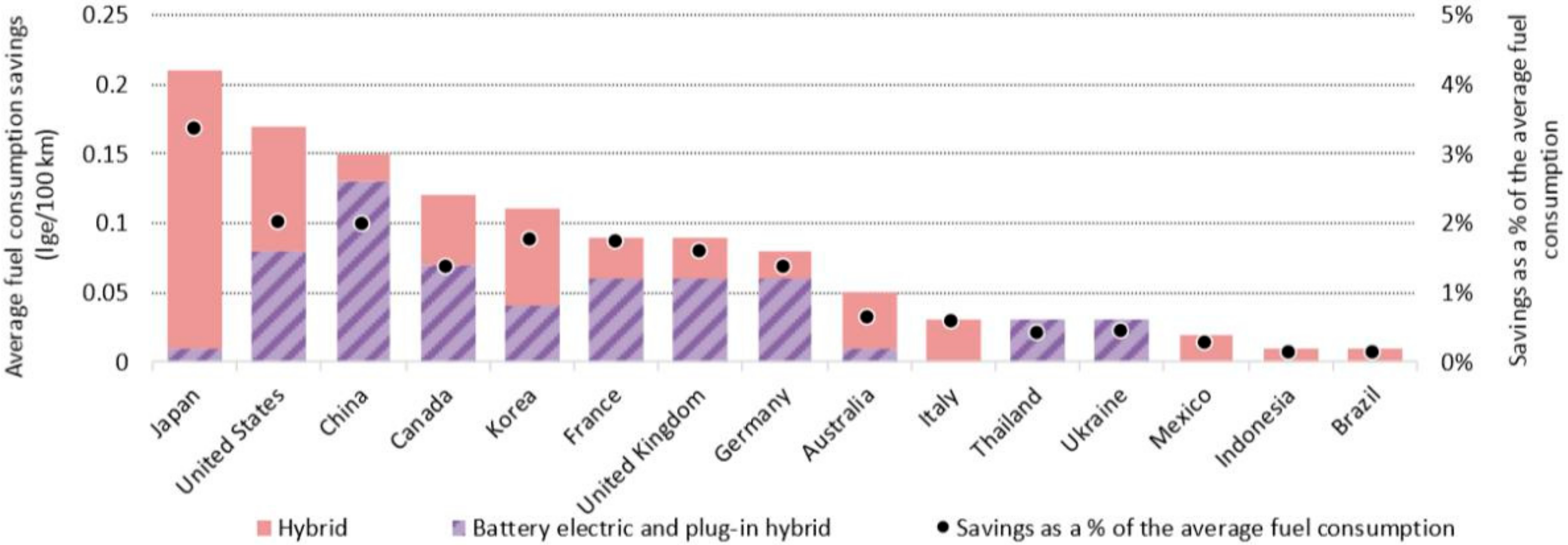

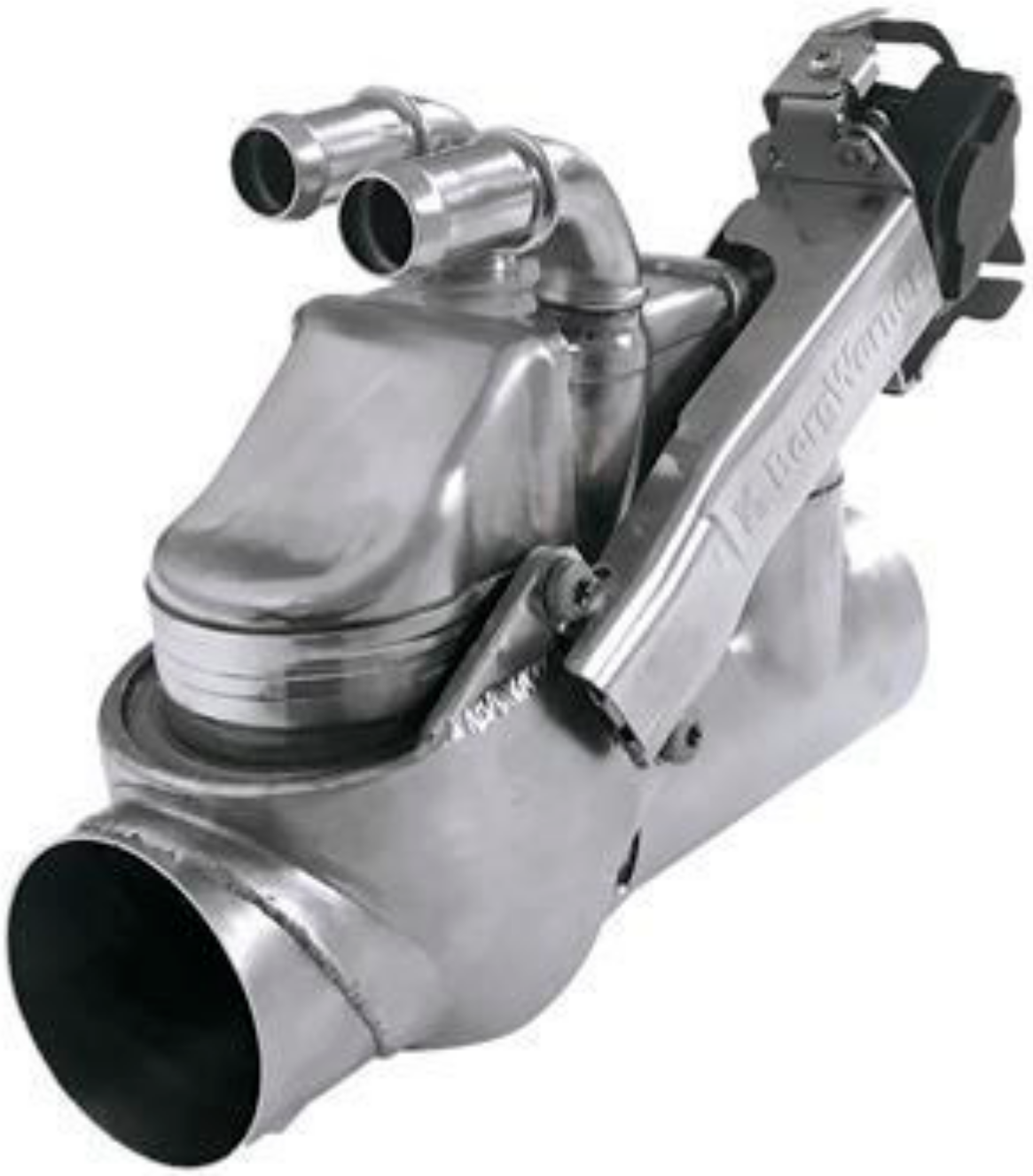


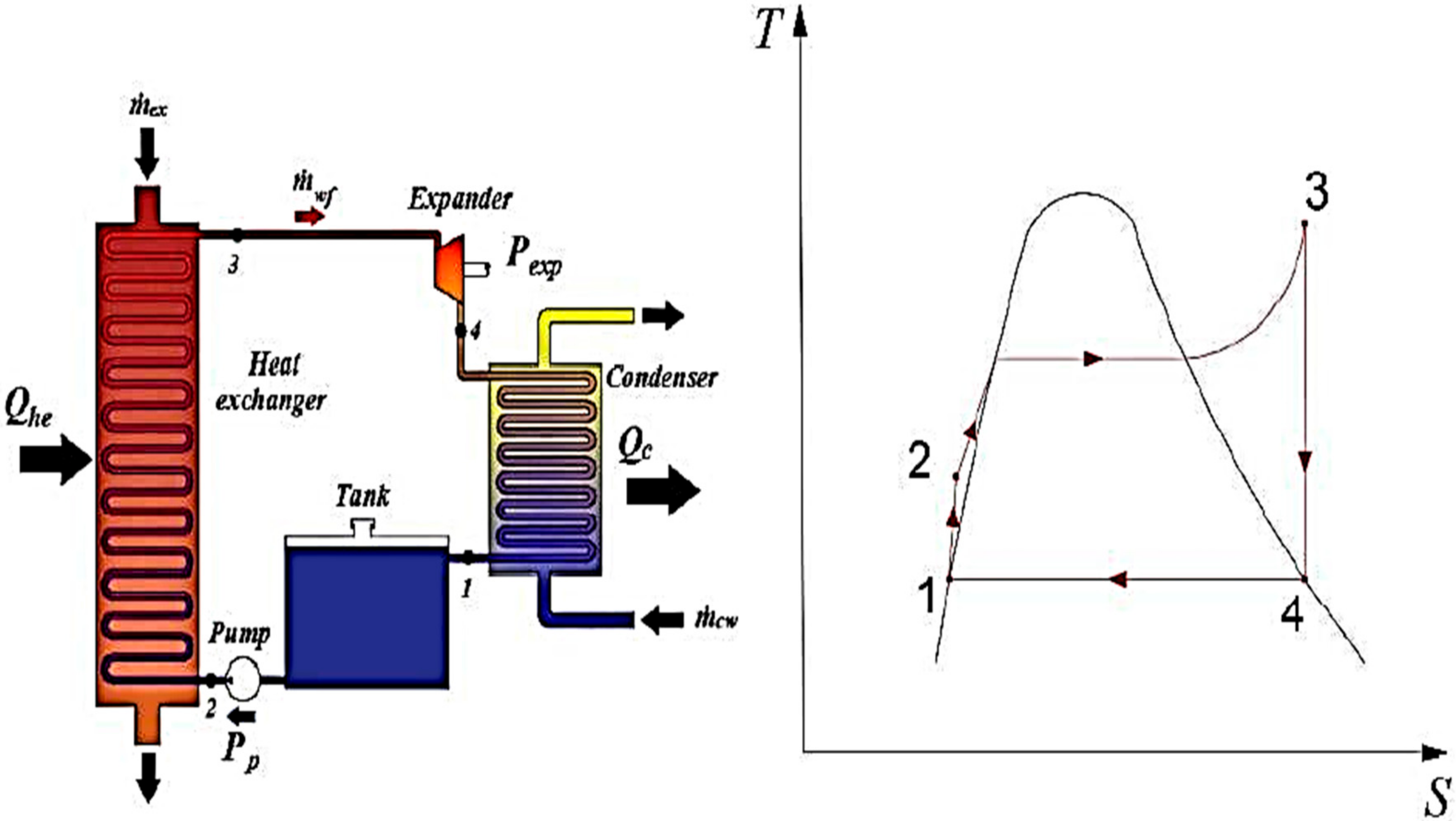

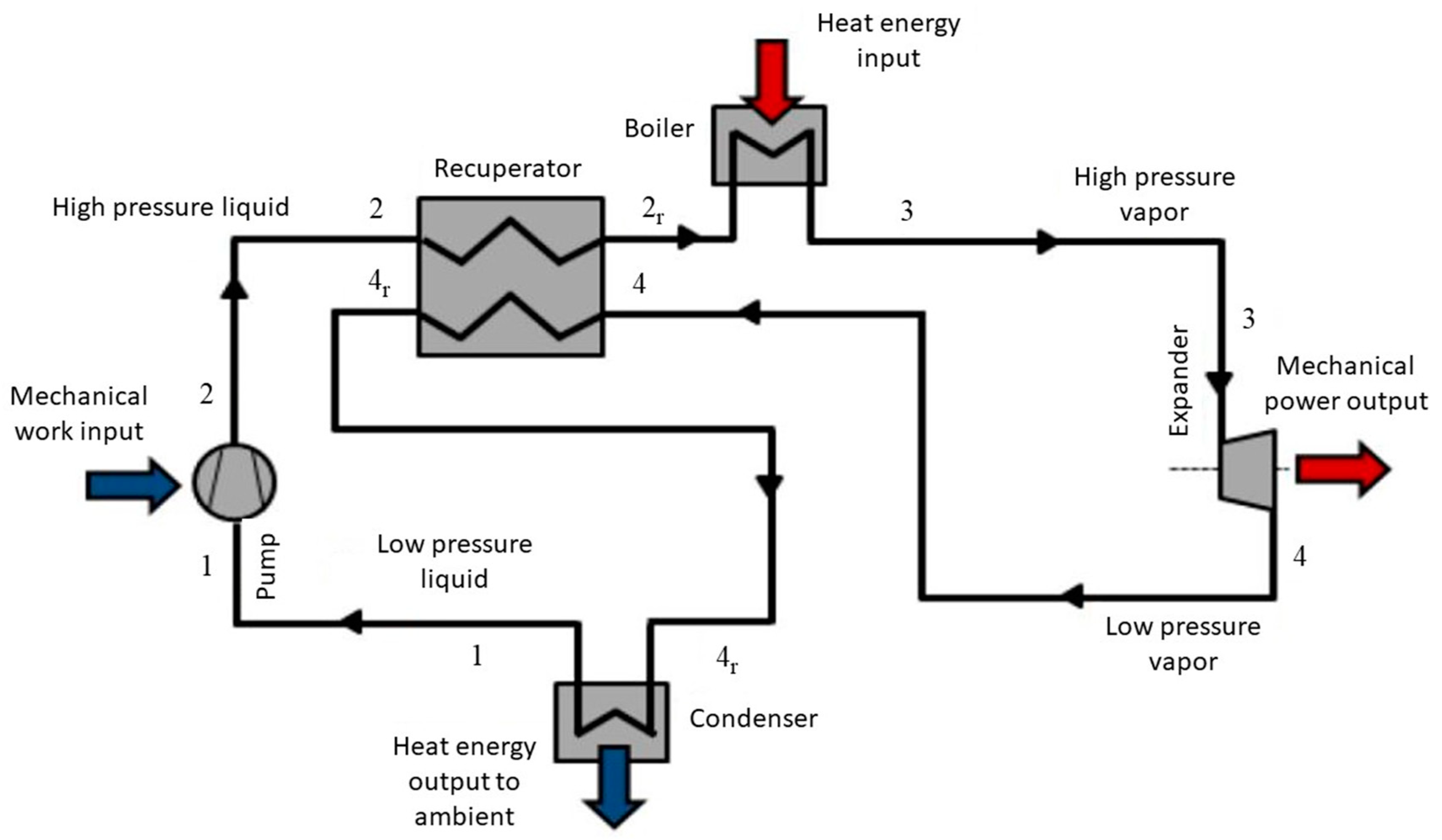

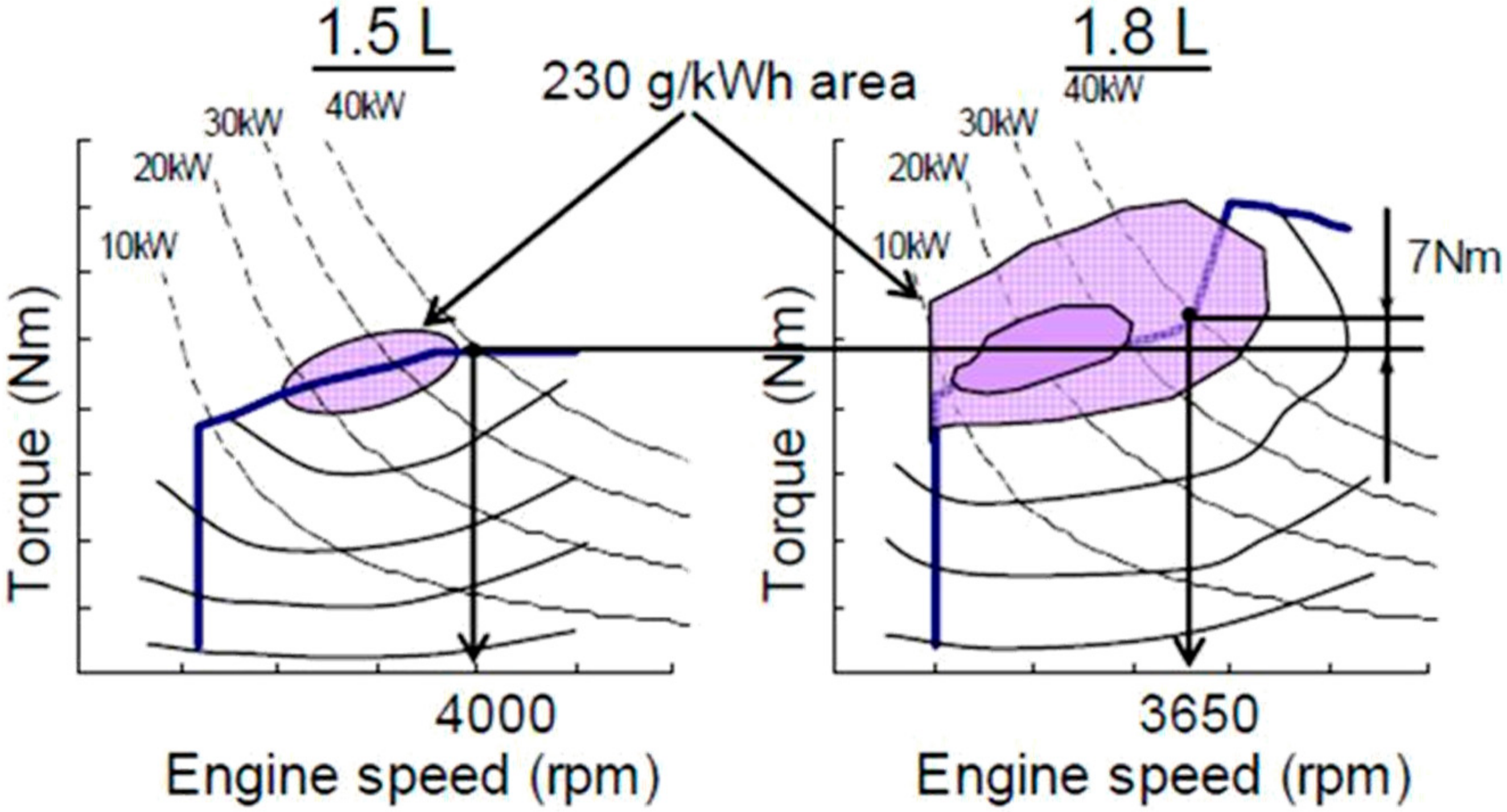
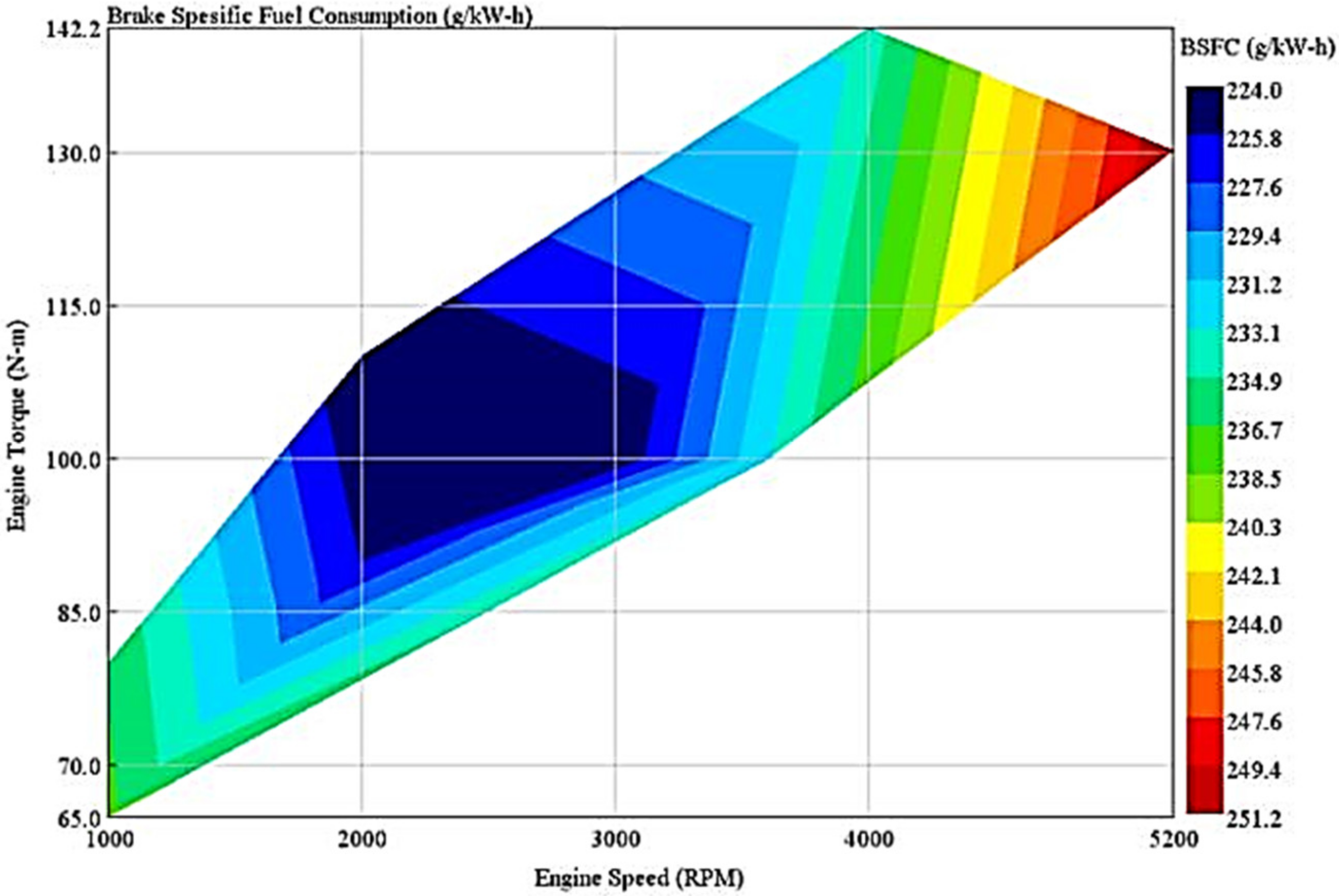


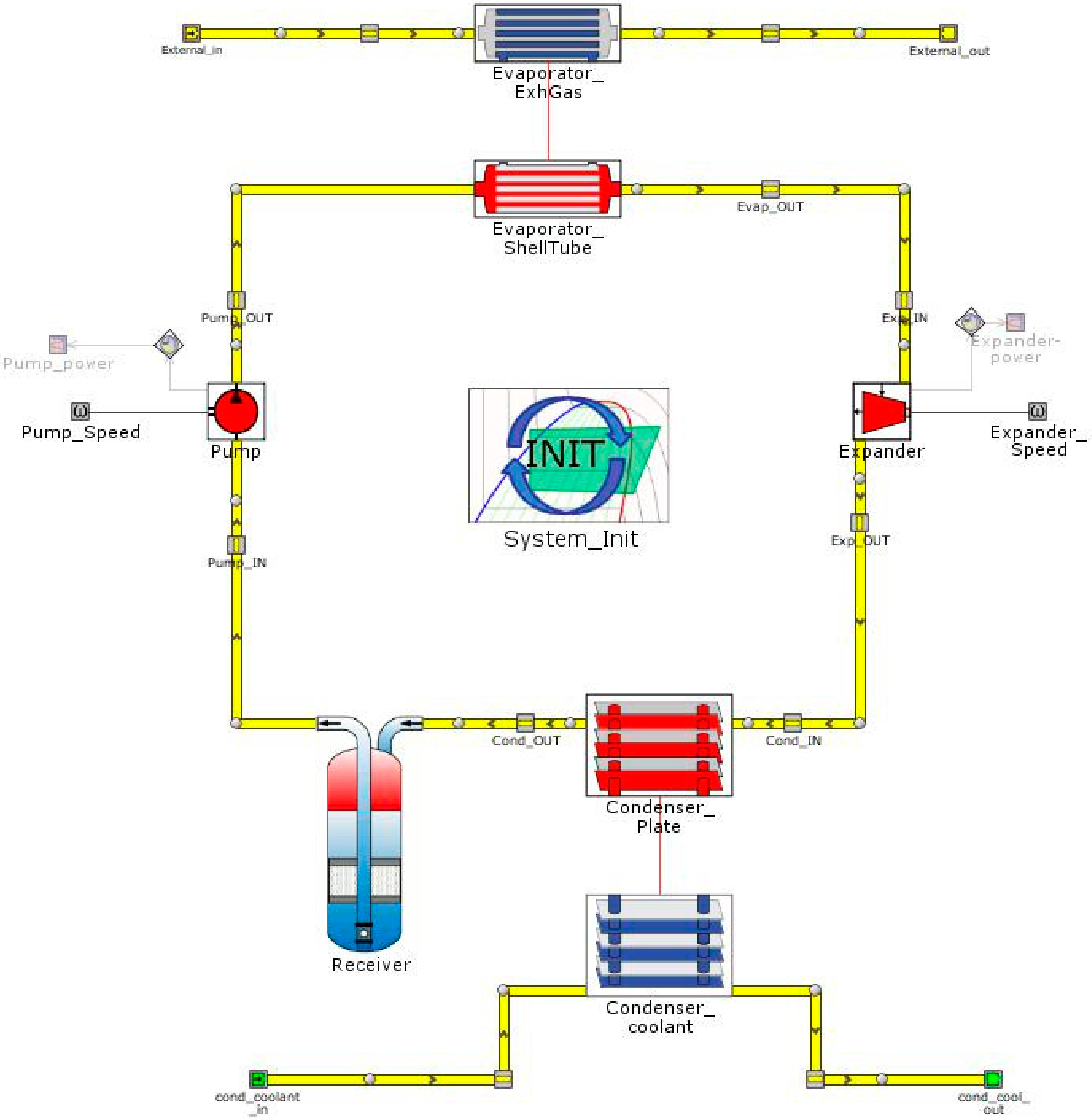
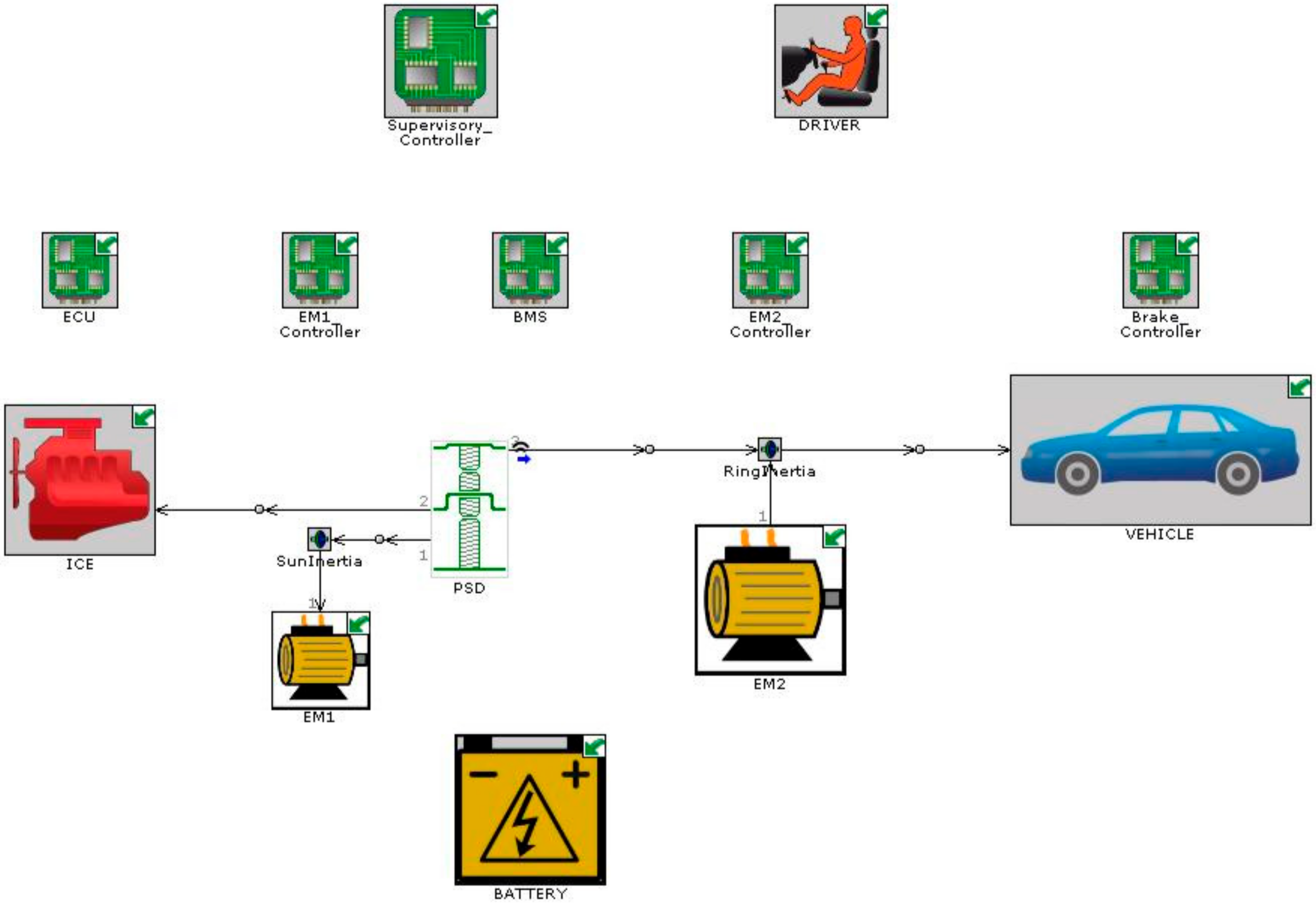
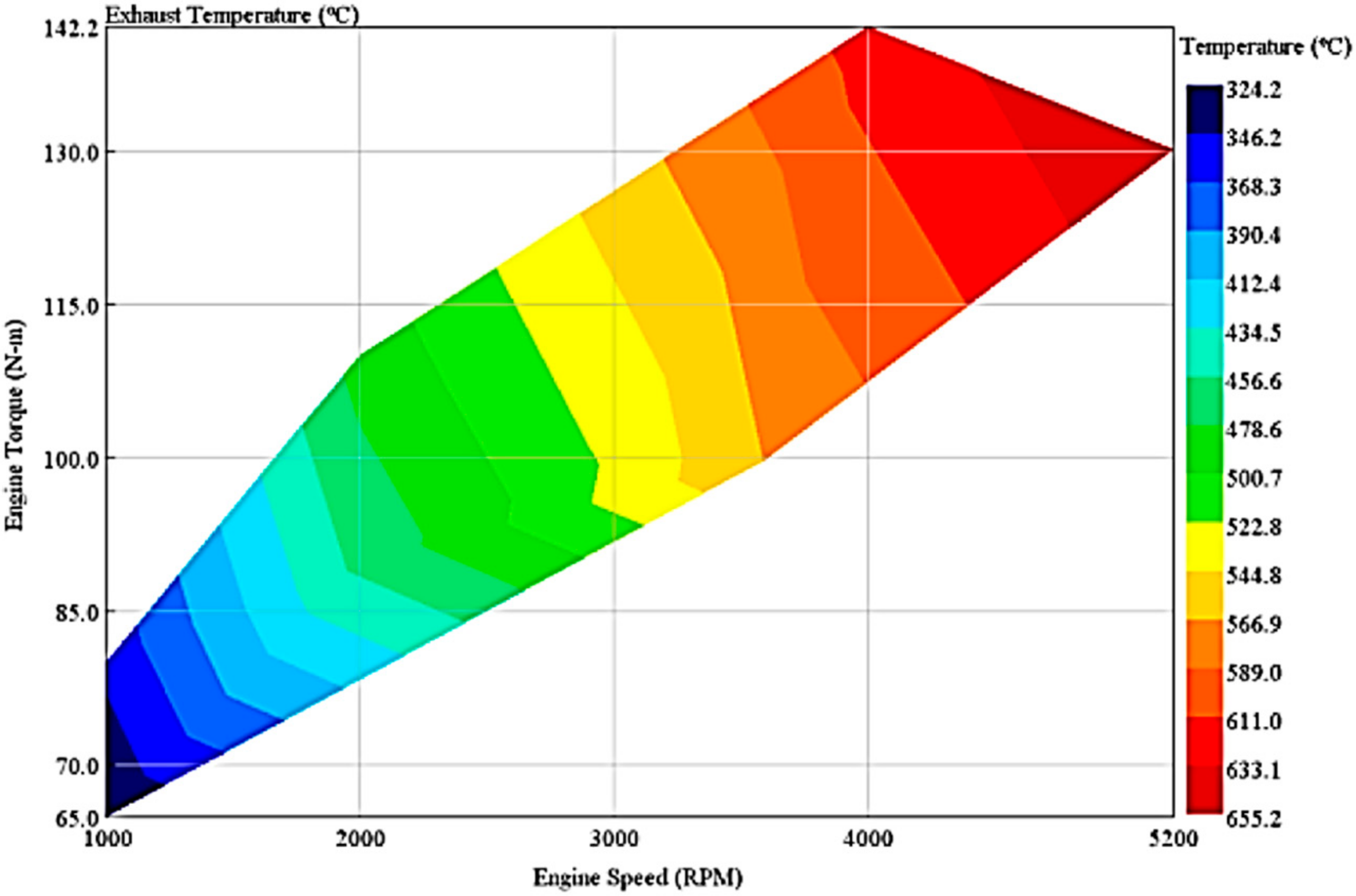
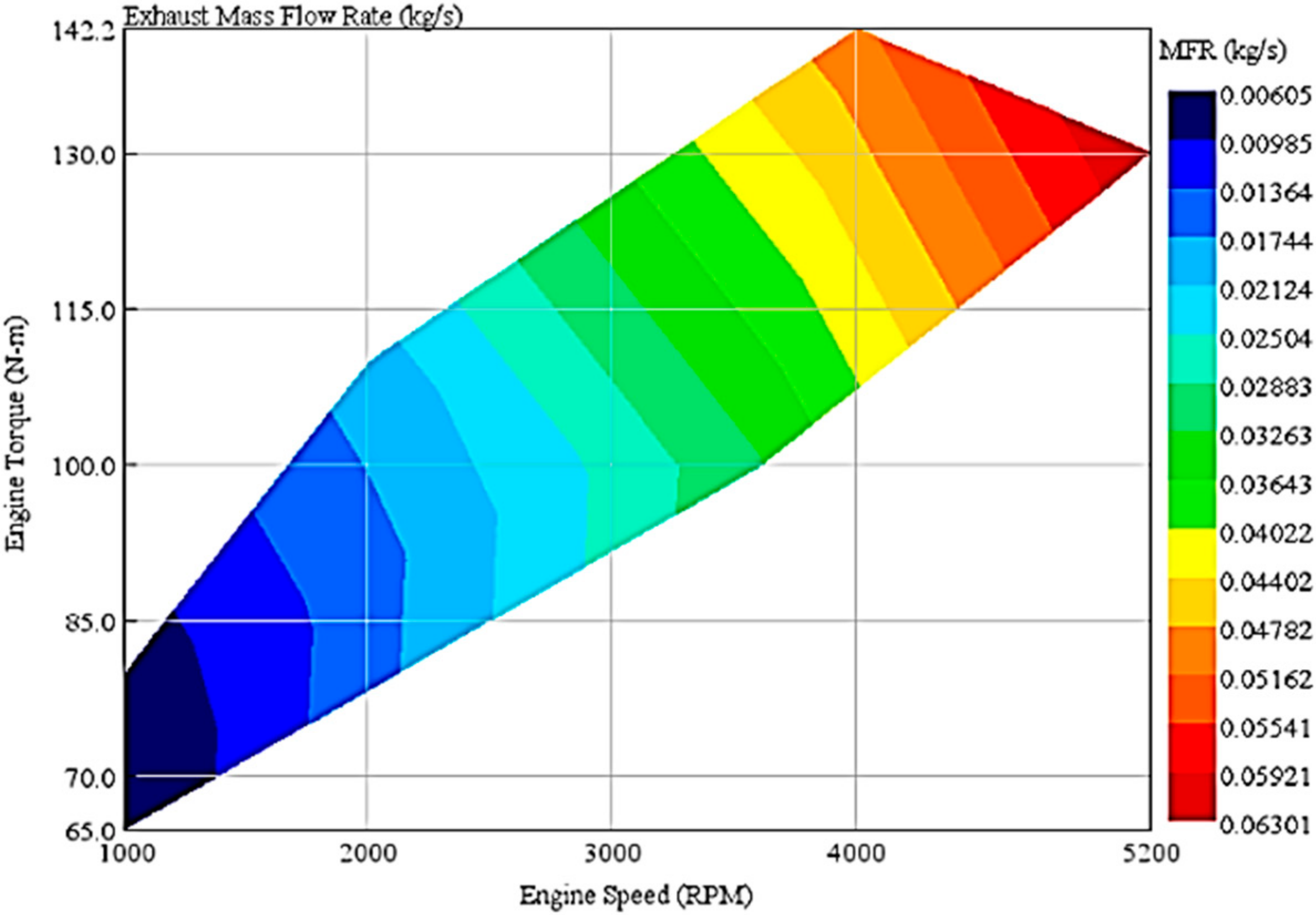
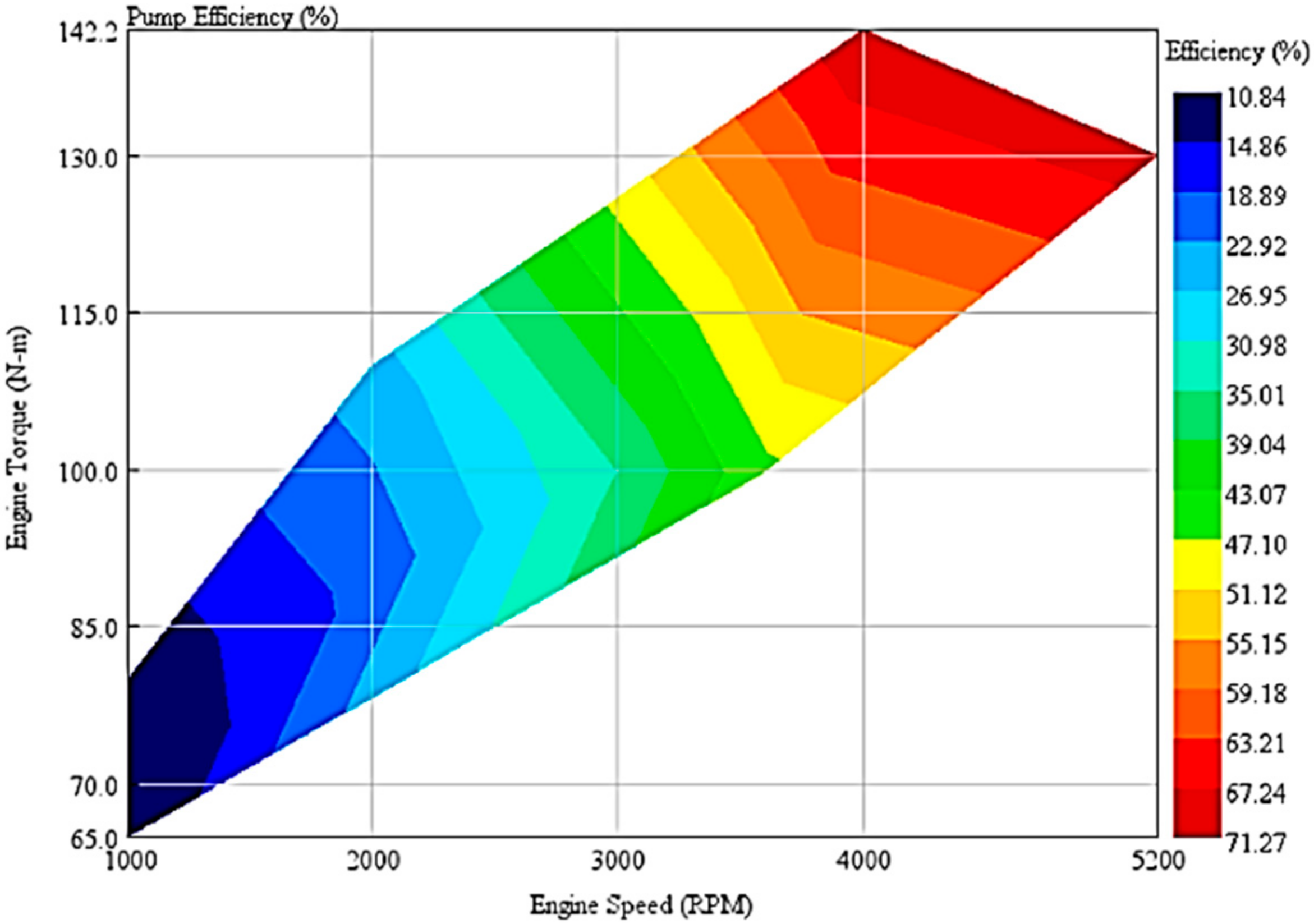
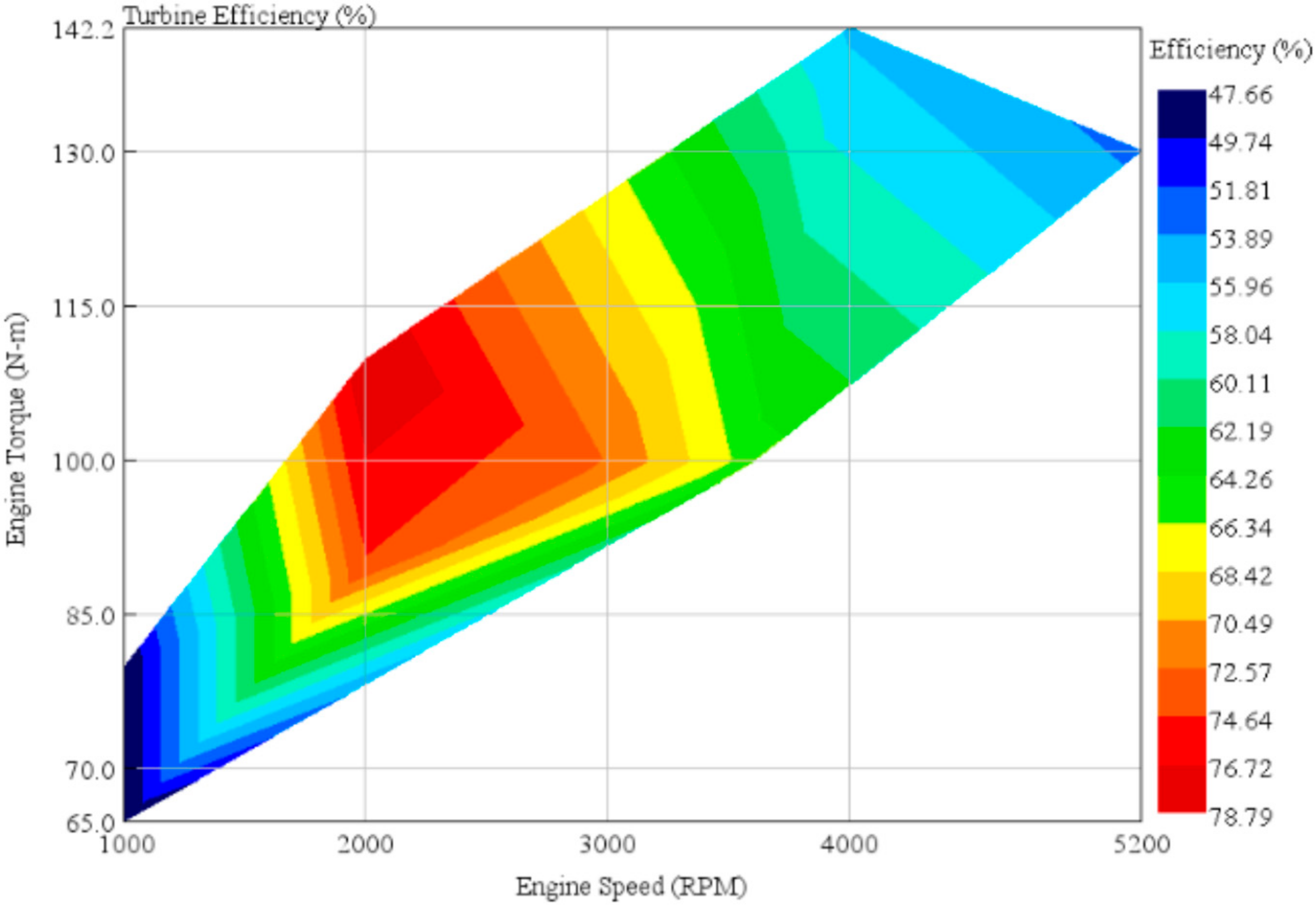
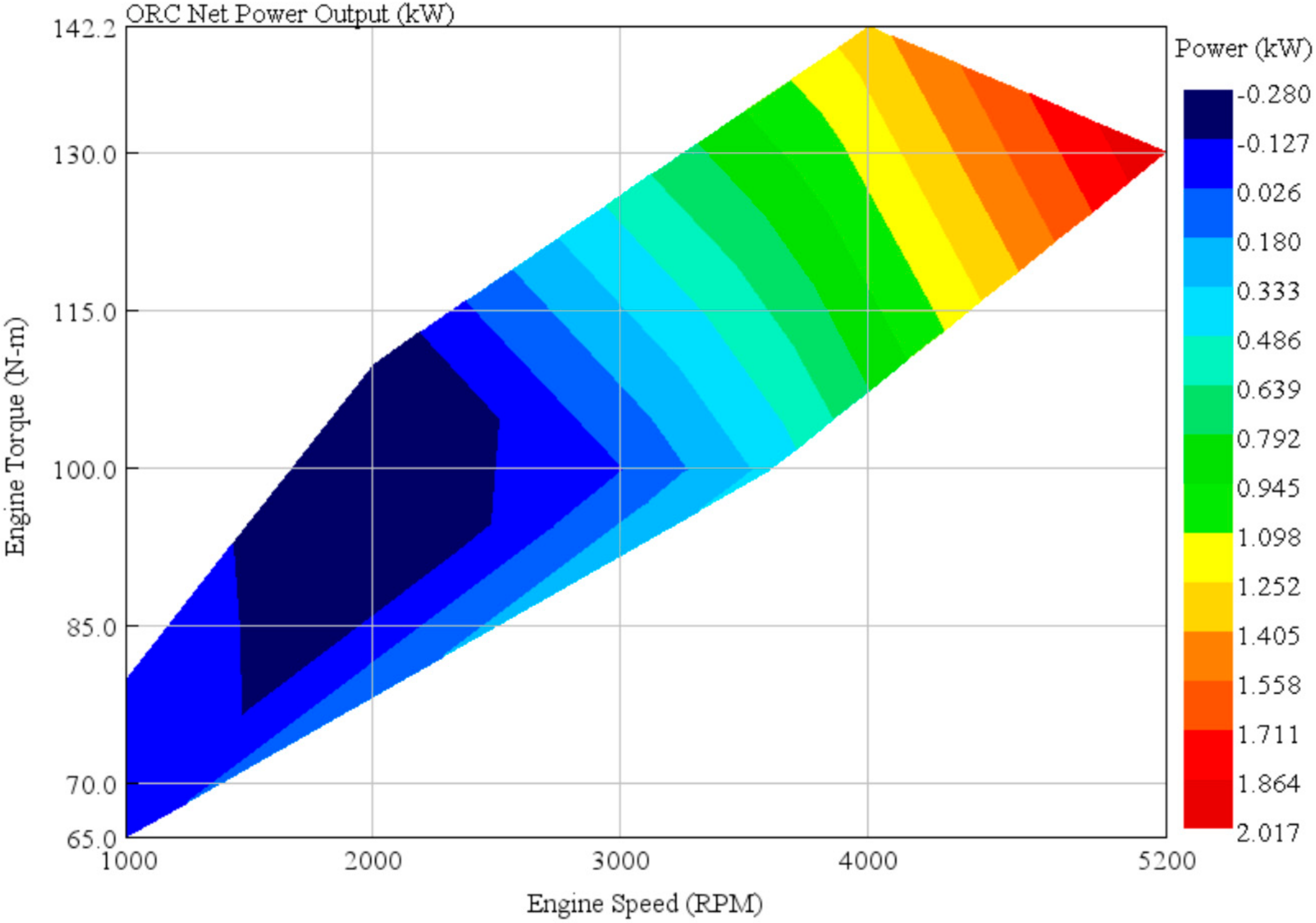


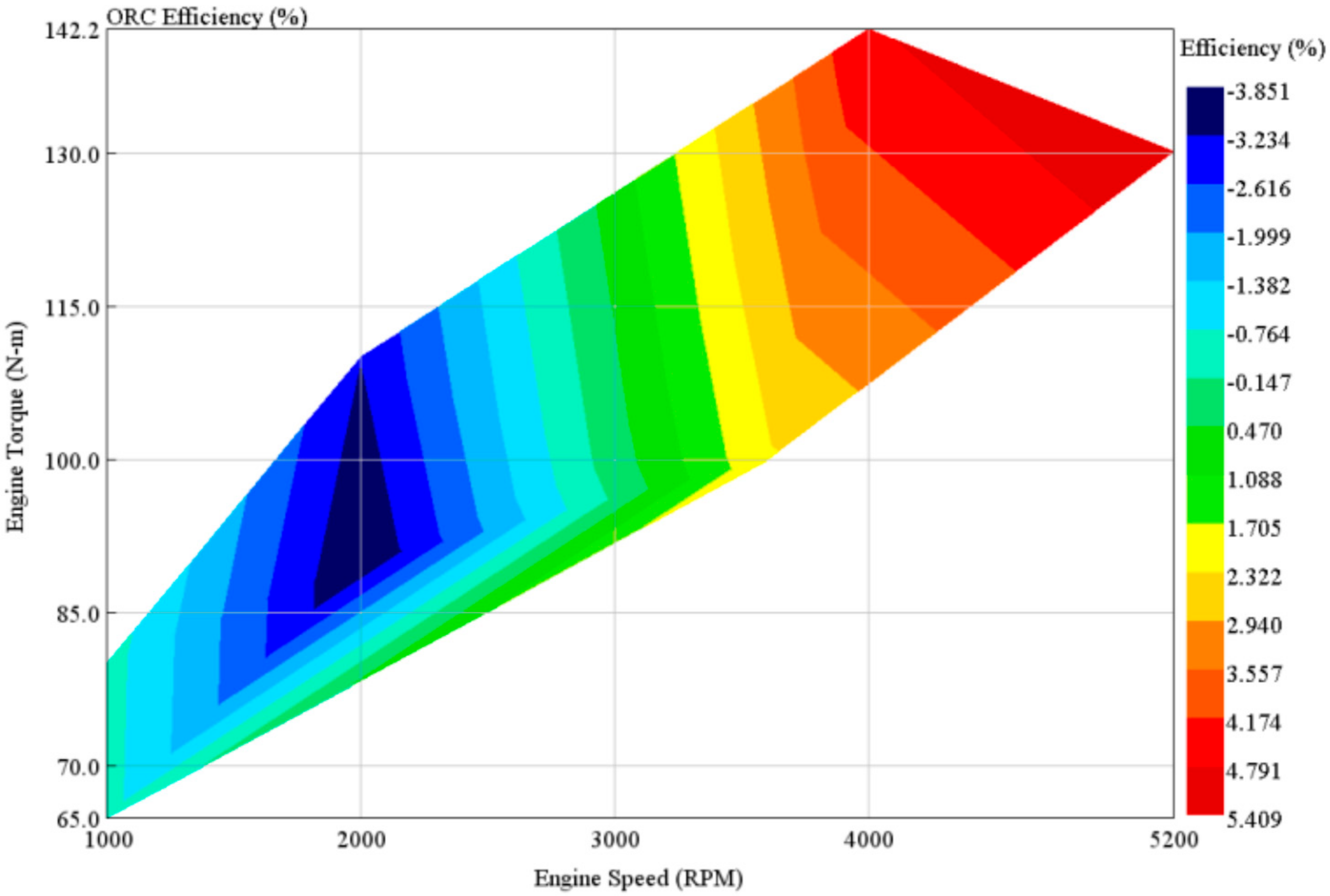


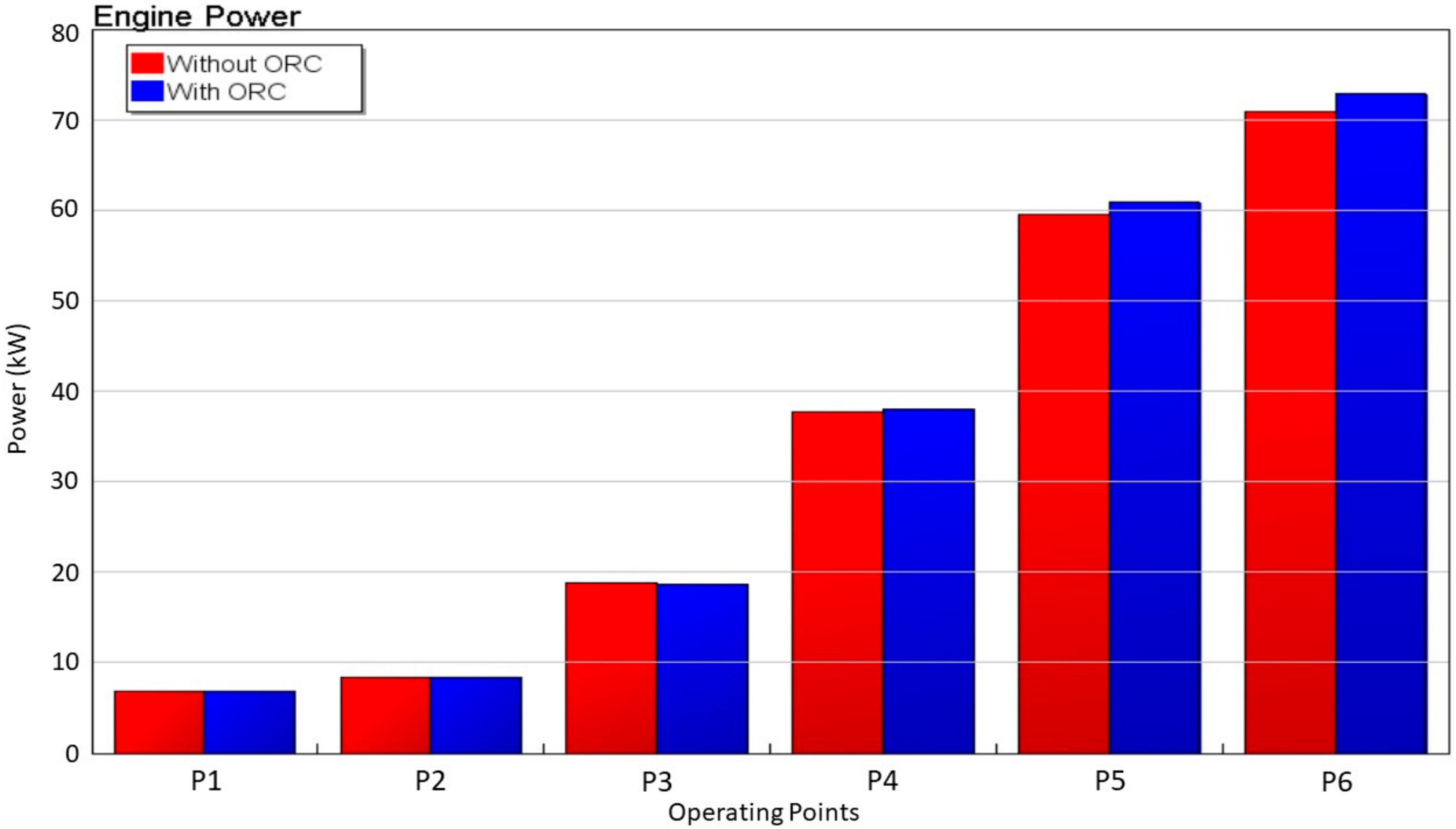



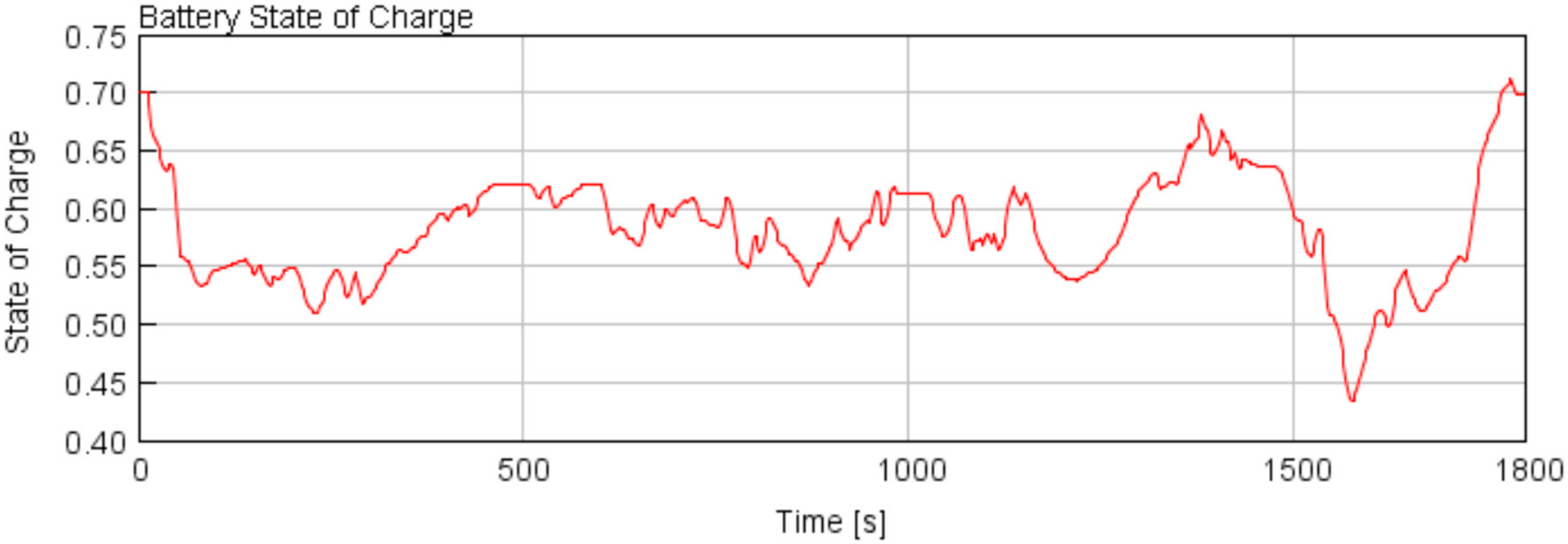
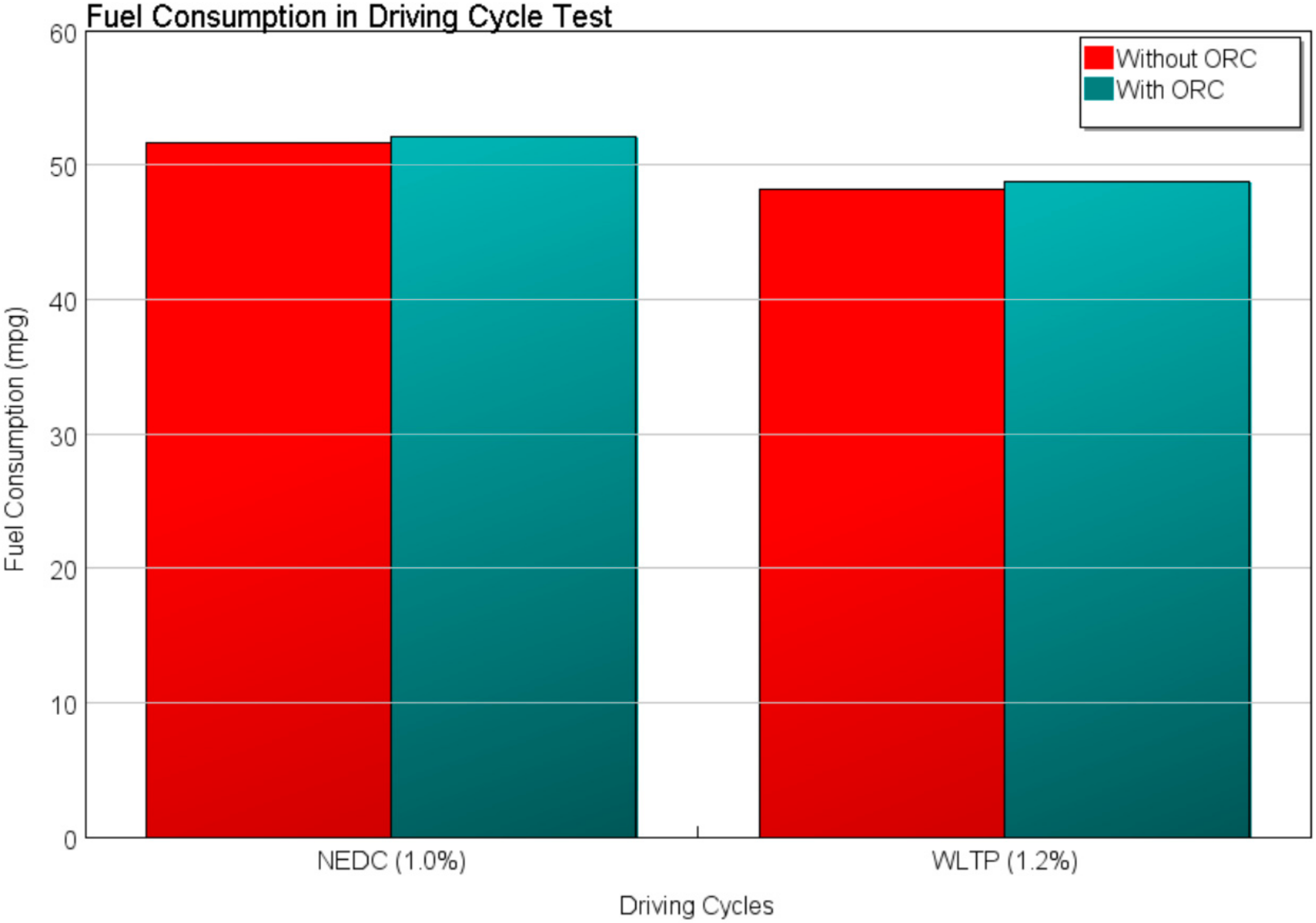

| Engine Specifications | |
|---|---|
| Engine code | 2ZR-FXE |
| Type | 4-cylinder, in-line (1.8-L Atkinson cycle petrol I4) |
| Valve mechanism | DOHC 16-valve with VVT-i |
| Fuel system | Electronic fuel injection |
| Displacement (cc) | 1798 |
| Compression ratio | 13.0:1 |
| Bore × stroke (mm) | 80.5 × 88.3 |
| Max. engine output (kW @ rpm) | 73 @ 5200 |
| Max. engine torque (Nm @ rpm) | 142 @ 4000 |
| Engine Speed (RPM) | Torque (Nm) | Theoretical | Calibrated | Error (%) | |
|---|---|---|---|---|---|
| P1 | 1000 | 65 | BSFC: 240 g/kWh | BSFC: 237.1 g/kWh | 1.21 |
| P2 | 1000 | 80 | BSFC: 230 g/kWh | BSFC: 236.5 g/kWh | 2.82 |
| P3 | 2000 | 90 | BSFC: 220 g/kWh | BSFC: 225.7 g/kWh | 2.59 |
| Power: 20 kW | Power: 18.86 kWh | 5.70 | |||
| P4 | 3600 | 100 | BSFC: 230 g/kWh | BSFC: 232.9 g/kWh | 1.26 |
| Power: 40 kW | Power: 37.72 kW | 5.70 | |||
| P5 | 4000 | 142 | BSFC: 240 g/kWh | BSFC: 234 g/kWh | 2.50 |
| P6 | 5200 | 130 | Power: 73 kW | Power: 70.91 kW | 2.86 |
© 2020 by the authors. Licensee MDPI, Basel, Switzerland. This article is an open access article distributed under the terms and conditions of the Creative Commons Attribution (CC BY) license (http://creativecommons.org/licenses/by/4.0/).
Share and Cite
Bin Wan Ramli, W.R.; Pesyridis, A.; Gohil, D.; Alshammari, F. Organic Rankine Cycle Waste Heat Recovery for Passenger Hybrid Electric Vehicles. Energies 2020, 13, 4532. https://doi.org/10.3390/en13174532
Bin Wan Ramli WR, Pesyridis A, Gohil D, Alshammari F. Organic Rankine Cycle Waste Heat Recovery for Passenger Hybrid Electric Vehicles. Energies. 2020; 13(17):4532. https://doi.org/10.3390/en13174532
Chicago/Turabian StyleBin Wan Ramli, Wan Rashidi, Apostolos Pesyridis, Dhrumil Gohil, and Fuhaid Alshammari. 2020. "Organic Rankine Cycle Waste Heat Recovery for Passenger Hybrid Electric Vehicles" Energies 13, no. 17: 4532. https://doi.org/10.3390/en13174532
APA StyleBin Wan Ramli, W. R., Pesyridis, A., Gohil, D., & Alshammari, F. (2020). Organic Rankine Cycle Waste Heat Recovery for Passenger Hybrid Electric Vehicles. Energies, 13(17), 4532. https://doi.org/10.3390/en13174532






